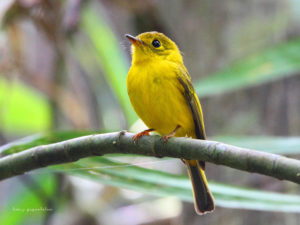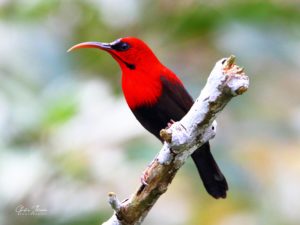A call to conserve Visayan birds

Citrine Canary Flycather.
photo/ Lisa J. Paguntalan
Without the help of local communities in the conservation of forests and birds, Cebu risks losing more bird species, said Cebuano ornithologist and researcher, Philip Godfrey Jakosalem.
Jakosalem, who is based in Negros Occidental, is among the authors of a new book, “Photographic Field Guide to the Birds of Negros, Panay and Cebu,” which was launched in Bacolod City last November 14.
The guide features the birds of Negros, Panay and Cebu which are considered as integral members of the ecosystem because of their crucial roles as pollinators, pest controllers and food sources for predators.
Bird manure serves as fertilizers and species such as the hornbills are excellent seed dispersers.

Magnificent Sunbird
“By studying and conserving birds, we understand their relationships and interactions with other species which also affect human beings,” said Jakosalem, who earned his Masters in Applied Ecology and Conservation from the University of East Anglia in England.
The book was launched without the photographs of two important birds endemic to Cebu: Cebu Flowerpecker and Cebu Brown Dove.
“They have never been photographed. In the IUCN (International Union for Conservation of Nature) Red List, they are classified as critically endangered species which means that they are close to becoming extinct. We do not want these species to be gone forever,” Jakosalem told Cebu Daily News.
IUCN is an international organization working for the conservation of nature and the sustainable use of natural resources.
“We lost our Cebu Flowerpecker before and we don’t want to lose it again,” he said of the bird which was believed to be extinct before it was rediscovered in 1992.
The Cebu Flowerpecker is considered the Holy Grail of Philippine bird photography as it has never ever been photographed.
Jakosalem said four birds, endemic to Cebu, are now extinct — the Cebu Oriole, two Cuckooshrike species (Blackish and Cebu bar-bellied Cuckooshrike), and the White-bellied Woodpecker.
Aside from the four bird species, Jakosalem said Cebu also lost the Cebu Warty Pig, Cebu Spotted Deer and the Cebu Dwarf Buffalo.
Meanwhile, Negros has two species of hornbills — the Visayan Hornbill and Rufous Headed Hornbill — which are both also classified as critically endangered.

Cebu Boobook or Cebu Hawk Owl
Conservation
The book is a collective effort of over 60 bird photographers from the Wild Bird Photographers of the Philippines, Provincial Governments of Negros Oriental and Negros Occidental, Department of Environment and Natural Resources (DENR), and Philippines Biodiversity Conservation Foundation, Inc. (PBCFI).
The book’s authors: Jakosalem, Lisa Paguntalan, Valentino L. Kintanar, S. Kieron M. Tan, Ramon J. Quisumbing, Romulo D. Quemado and Tateo Osawa come from a diverse pool of photographers, ornithologists and researchers.
Jakosalem said it took them one year and two months to gather all their photos to come out with a comprehensive field guide.
Paguntalan, executive director of PBCFI, said they hope to reprint at least 500 copies for distribution in Cebu.
“This has the most complete collection of water birds and forest birds in Cebu, Negros and Panay,” she told CDN.
The book was also published to support researchers, conservationists, and bird enthusiasts in the research and biodiversity monitoring of protected areas; as well as for DENR’s monitoring of water birds.
The book’s publication is supported by the United States Agency for International Development (USAID) through the PhilAm Fund, Zoological Society of London – Philippines and Ford Fellowship.
Unique
The Handbook of the Birds of the World, a publication produced by Spanish publishing house Lynx Editions in partnership with BirdLife International, listed 11,122 bird species worldwide excluding potential new species.
In the Visayas region, there are unique species that can only be found in Cebu such as the Cebu Flowerpecker and the Cebu Brown Dove (scientific name: Phapitreron frontalis) which is also classified as critically endangered with less than 49 birds in its population.
The dove species has not been recorded with certainty since 1892 because of the effects of ongoing habitat loss and degradation; but there were possible sightings in 2004 and several reports between 2007 to 2012.
Cebu also has the Black Shama, locally known as “siloy,” a melodious songster found in the remaining forests and tree plantations of Cebu.
The Central Cebu Protected Landscape (CCPL) is currently the only protected area where the Siloy is found while its largest population is in the forests of Alcoy and Boljoon towns which are protected by local community forest wardens.
Siloy
Jakosalem recounted that while researchers were doing an ecological study of the siloy in Alcoy’s Nug-as Forest, they found a siloy’s nest with cuckoo bird.
“A cuckoo (was) parasitizing the siloy’s nest. Eventually, the two baby siloys were killed while the baby cuckoo survived,” he said.
Jakosalem said both male and female siloy fed the cuckoo, treating the bird as their own.
“The siloy parents had to work double time to feed the adopted chick. They fed the cuckoo small snakes, insects, snails, caterpillar and many insects. We were amazed by the behavior of the siloys,” he said.
The Nug-as forest wardens were concerned and wanted to remove the cuckoo from the nest especially when they saw it harming the siloy hatchlings.
“But we told them to let the birds be because that is natural selection. That is how nature works,” he said.
In studies and lectures on biodiversity conservation, Jakosalem said they enphasize the diversity of birds species and their habitats.
“Different species of birds cannot live in the same habitat at the same time,” he said.
Call to action
Jakosalem encouraged everyone to pick up birdwatching as a hobby to help raise awareness on the Visayas region’s rich biodiversity.
A birdwatcher only needs a pair of binoculars.
Birds, he said, are species that indicate how healthy or threatened the forests are.
“If people can understand and recognize birds as a flagship species for conservation, we are not just conserving the birds and the forest, we are also protecting ourselves,” he said.
Jakosalem added that participation in conservation programs can lead to higher awareness on biodiversity conservation and other environmental issues.
“When people participate in monitoring activities, they will learn why some species are threatened or why some species are gone forever,” he said.
He said Cebuanos are lucky because Lapu-Lapu City’s Olango Island Wildlife Sanctuary is a haven for migratory birds, which migrate to the area from October to February or during the cold winter months of Russia and China.
“We can watch birds in Olango and be amazed about how these birds travel for 20,000 to 25,000 kilometers per migration every year; or look at the courtship behaviors of flowerpeckers and the relations with mistletoe (bird),” he said.
Jakosalem reminded watchers and photographers to practice good ethics in bird photography and birdwatching.
“We want to involve more people in this cause because that would mean more voices for the conservation of birds, their habitats, and our work in protecting and conserving our biodiversity in general,” he said.
Disclaimer: The comments uploaded on this site do not necessarily represent or reflect the views of management and owner of Cebudailynews. We reserve the right to exclude comments that we deem to be inconsistent with our editorial standards.
